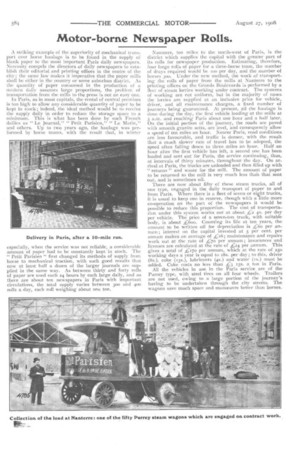Motor-borne Newspaper Rolls.
Page 6

If you've noticed an error in this article please click here to report it so we can fix it.
A striking example of the superiority of mechanical transport over horse haulage is to be found in the supply of blank paper to the most important Paris daily newspapers. Necessity compels the directors of daily newspapers to establish their editorial and printing offices in the centre of the city; the same law makes it imperative that the paper mills shall be either in the country or some suburban district. As the quantity of paper consumed in the production of a modern daily assumes large proportions, the problem of transportation from the mills to the press is not an easy one.
In Paris, as in most capitals, the rental of central premises is too high to allow any considerable quantity of paper to be kept in stock; indeed, the ideal method would be to receive the supply daily in order to reduce the storage space to a minimum. This is what has been done by such French dailies as " Le journal," " Petit Parisien," "Le Malin," and others. Up to two years ago, the haulage was performed by horse teams, with the result that, in winter
especially, when the service was not reliable, a considerable amount of paper had to be constantly kept in stock. The " Petit Parisien " first changed its methods of supply from horse to mechanical traction, with such good results that now at least half a dozen of the larger journals arc supplied in the same way. As between thirty and forty rolls of paper are used each 24 hours by each large daily, and as there are about ten newspapers in Paris with important circulations, the total supply varies between 300 and 400 rolls a day, each roll weighing about one ton.
Nanterre, ten miles to the north-west of Paris, is the district which supplies the capital with the greater part of its rolls for newspaper production. Estimating, therefore, four large rolls of paper for a three-horse team, the number of drays required would be too per day, and the number of horses 30o. Under the new method, the work of transporting the rolls of paper from the mills at Nanterre to the printing offices on the Grands Boulevards is performed by a fleet of steam lorries working under cOntract. The systems of working are not uniform, but in the majority of cases the lorries are supplied at an inclusive price for vehicle, driver, and all maintenance charges, a fixed number of journeys being guaranteed. At present, all the haulage is done during the day, the first vehicle loading at the mills at 5 a.m. and reaching Paris about one hour and a half later. On the initial portion of the journey, the roads are paved with smooth granite setts, are level, and consequently allow a speed of ten miles an hour. Nearer Paris, road conditions are less favourable, and traffic is denser, with the result that a much slower rate of travel has to be adopted, the speed often falling down to three miles an hour. Half ao hour after the first vehicle has left, a second one has been loaded and sent out for Paris, the service continuing, thus, at intervals of thirty minutes, throughout the day. On arrival at Paris, the trucks are unloaded and then filled up with " returns " and waste for the mill. 'The amount of paper to be returned to the mill is very much less Utah that sent Out, and is sometimes nil.
There are now about fifty of these steam trucks, all of one type, engaged in the daily transport of paper to and from Paris. Where there is a fleet of seven or eight trucks, it is usual to keep one in reserve, though with a little more co-operation on the part of the newspapers it would be possible to reduce this proportion. The cost of transportation under this system works out at about ,r."/ 4s. per day per vehicle. The price of a seven-ton truck, with suitable body, is about 4.600. Counting its life at ten years, the amount to be written off for depreciation is -1:60 per annum; interest on the capital invested at 5 per cent. per annum makes an average of ;(,16; maintenance and repairs work out at the rate of L7o per annum; insurances and licenses are calculated at the rate of ,,24 per annum. This gives a total of Ac,e7o per annum, which at the rate of 25o working days a year is equal to 18s. per day ; to this, driver (8s.), coke (135.), lubricants (45.) and water (rs.) must be
added. Coke costs no less than is. a ton in Paris.
All the vehicles in use in the Paris service are of the Purrey type, with steel tires on all four wheels. Trailers are not used, owing to a large portion of the journey's haying to be undertaken through the city streets. The wagons save much space and maneeuvre better than horses.




















